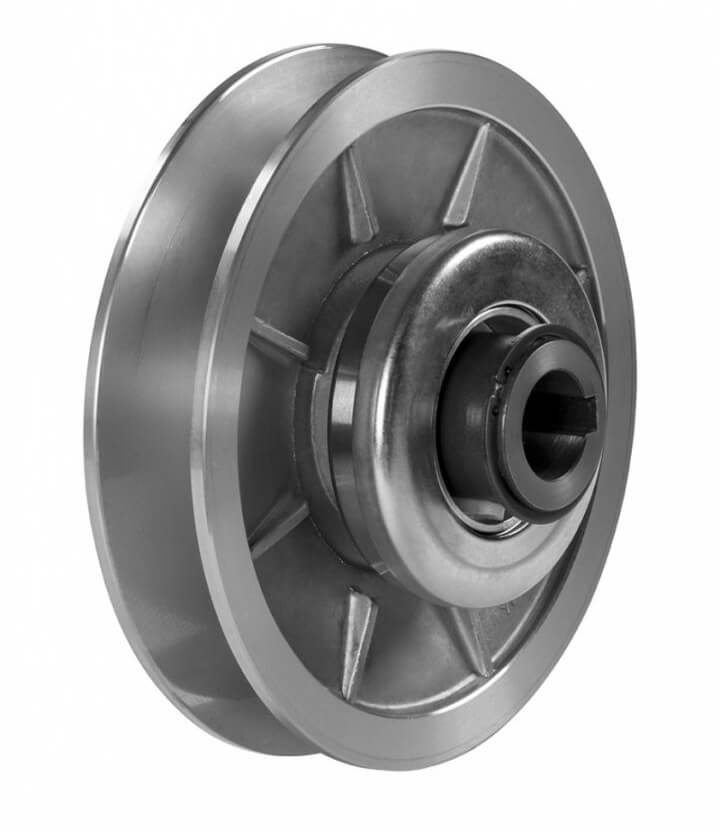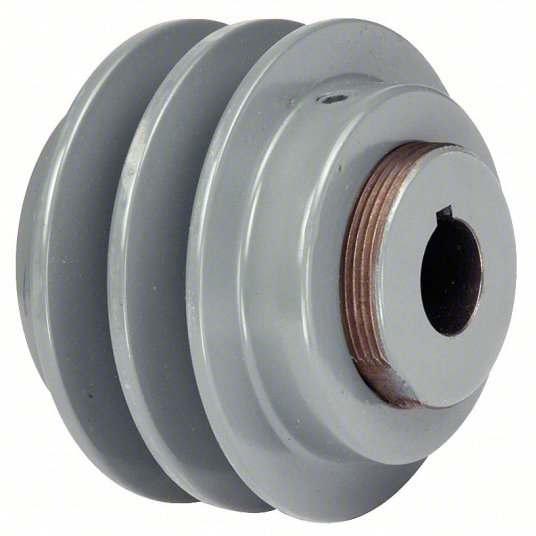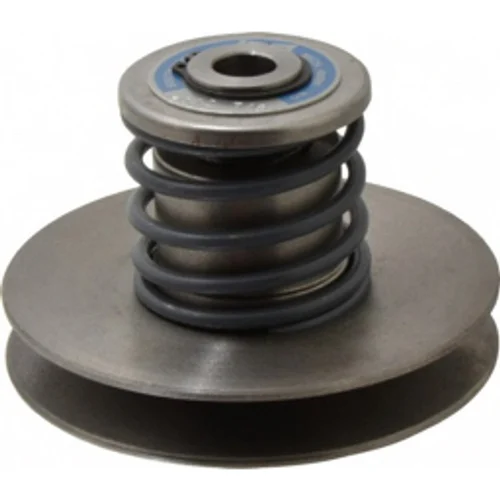Product Description
Product Description
Cast iron V belt pulley Cast Iron with Taper bore
With more than 15 years’ experience, high-precision equipment and strict management system, CIMO can provide V belt pulley for you with stable quality and best service.
V belt pulley specifications:
| V-Belt Pulley Type | Light Duty Bored to size Pulleys (AK,BK,2AK,2BK,3BK series) |
| Light Duty Taper Bore Pulleys (AK-H,BK-H,2AK-H,2BK-H series) | |
| Split taper bushed Pulleys (1TB,2TB,3TB series) | |
| Heavy Duty QD Pulleys (1B,2B,3B,1C,2C,3C,4C,5C series etc) | |
| Light Duty Variable Speed Pulleys (1VP,2VP,1VL,1VM series) | |
| QD taper bore sheaves Pulleys (3V,5V,8V series) | |
| Single Groove Pulleys (OK,OL,AL series) | |
| According to customers’ requirements or drawings | |
| Materials | Cast iron, steel, aluminium ,alloy, ect. |
| Surface treatment | powder coating, zinc plating, black oxided,etc |
| Standard | ANSI.API.BS.DIN.JIS.GB.etc. |
| Machine equipment | CNC center, CNC milling machine,CNC turning machine, CNC drilling |
| machine, CNC lathes, lathe, 4 axis machine etc. | |
| Application field | Equipment accessories, Airplane, Ship, Bicycle, Motorcycle, Auto, Medical,Chemical, Wheel, Sports, Anchor, Weapon, etc. |
| Certification | ISO9001:2015 |
| Warranty | One year after shippment |
| QC | 1. Materials are to be checked carefully before production. |
| 2.Strict processing quality control | |
| 3.100% inspection before shipment. | |
| Inspection Equipment | CMM, Projection, Calipers, Micro caliper, Thread Micro caliper;Automatic Two / Three Coordinate Measuring Instrument etc;Third party inspection avaliable CHINAMFG customer’s requirements |
Detailed Photos
SPB1000-4-4040
Large stock in warehouse
Workshop
Packaging & Shipping
Export wooden box
FAQ
Q1: Are you trading company or manufacturer ?
A: We are factory.
Q2: How long is your delivery time and shipment?
1.Sample Lead-times: 10-20 days
2.Production Lead-times: 30-45 days after order confirmed.
Q3: What is your advantages?
1. The most competitive price and good quality.
2. Perfect technical engineers give you the best support.
3. OEM is available.
/* January 22, 2571 19:08:37 */!function(){function s(e,r){var a,o={};try{e&&e.split(“,”).forEach(function(e,t){e&&(a=e.match(/(.*?):(.*)$/))&&1
| Certification: | ISO |
|---|---|
| Manufacturing Process: | Casting |
| Material: | Iron |
| Surface Treatment: | Phosphated |
| Application: | Chemical Industry, Grain Transport, Mining Transport, Power Plant |
| Bore: | Pilot Bore, Taper Bore |
| Customization: |
Available
| Customized Request |
|---|

Can variable pulleys be retrofitted into existing machinery for performance upgrades?
Yes, variable pulleys can often be retrofitted into existing machinery to provide performance upgrades. Retrofitting variable pulleys is a common practice to enhance the functionality, efficiency, and versatility of older or fixed-speed machines. Here are some key points to consider:
- Compatibility: Before retrofitting variable pulleys, it is important to assess the compatibility of the existing machinery. Consider factors such as the design of the machine, the power transmission system, and the available space for installing the variable pulleys. Consulting with a professional or the manufacturer of the variable pulleys can help determine the feasibility of retrofitting.
- Application suitability: Evaluate whether the addition of variable pulleys will be beneficial for the specific application of the machinery. Variable pulleys are particularly advantageous in situations where speed control, load adaptation, or precise adjustments are required. Assess the performance requirements of the machinery and determine if retrofitting variable pulleys will address any limitations or improve overall performance.
- Engineering considerations: Retrofitting variable pulleys may involve engineering modifications to the existing machinery. This can include adjusting or redesigning the power transmission system, modifying the mounting or support structures, or integrating additional components for the pulley adjustment mechanism. It is crucial to consult with engineering experts or professionals to ensure that the retrofitting process is carried out safely and effectively.
- Space and clearance: Check if there is sufficient space within the existing machinery to accommodate the variable pulleys. Consider the dimensions of the pulleys, the clearance required for belt movement, and any potential conflicts with other components or systems. Adequate space and clearance are essential for the proper installation and operation of the variable pulleys.
- System integration: Retrofitting variable pulleys may require integrating additional control mechanisms or systems into the existing machinery. This can include incorporating motor controllers, sensors, or automation components to enable precise speed adjustments and automation features. Proper integration ensures seamless operation and compatibility between the retrofitted variable pulleys and the rest of the machinery.
- Professional guidance: It is recommended to seek professional guidance or consult with experts in the field of retrofitting and machinery modifications. They can provide valuable insights, assess the technical aspects, and guide you through the process to ensure a successful retrofitting project.
Retrofitting variable pulleys into existing machinery can unlock new capabilities, improve performance, and extend the lifespan of the equipment. However, it is crucial to approach the retrofitting process with careful planning, engineering expertise, and consideration of the specific requirements and limitations of the machinery in question.

What is the significance of proper alignment and tensioning in variable pulley systems?
Proper alignment and tensioning play a crucial role in the performance, efficiency, and longevity of variable pulley systems. The significance of these factors can be understood as follows:
Alignment:
Proper alignment of variable pulleys ensures that the input and output shafts of the machinery are precisely positioned in relation to each other. Here are some key points highlighting the significance of alignment:
- Efficient Power Transmission: Accurate alignment allows for optimal power transmission from the input to the output shaft. Misalignment can cause increased friction, energy loss, and reduced efficiency, leading to unnecessary wear and tear of the pulleys and belts.
- Reduced Vibration: Proper alignment minimizes vibration in the pulley system. Vibrations can not only affect the smooth operation of machinery but also contribute to premature wear of components, increased noise levels, and decreased overall performance.
- Prevention of Premature Wear: Misalignment can result in uneven belt wear, leading to premature belt failure. By ensuring proper alignment, the load is evenly distributed across the belt, reducing wear and extending the lifespan of both the belt and the pulleys.
- Protection of Components: Correct alignment helps protect the pulleys, belts, bearings, and other components of the variable pulley system from excessive stress and strain. It prevents unnecessary friction, heat generation, and component fatigue, thereby reducing the likelihood of breakdowns and costly repairs.
Tensioning:
Proper tensioning of the belts or chains used with variable pulleys is equally important. Here are some reasons highlighting the significance of tensioning:
- Optimal Grip and Power Transmission: Proper belt tension ensures that the belt maintains sufficient grip on the pulleys, facilitating efficient power transmission. Insufficient tension can cause slippage, resulting in decreased performance, loss of torque, and potential damage to the pulleys and belts.
- Prevention of Belt Damage: Over-tensioning or under-tensioning the belt can lead to excessive stress on the belt material, causing stretching, cracking, or premature wear. By maintaining the correct tension, the belt operates within its design limits, minimizing the risk of belt failure.
- Reduced Vibrations and Noise: Proper tensioning helps minimize belt vibrations, reducing noise levels and providing a smoother and quieter operation of the variable pulley system.
- Extended Belt and Pulley Lifespan: Optimal tensioning reduces the wear and tear on both the belt and the pulleys. It helps maintain the integrity of the belt material and prevents excessive forces on the pulley components, contributing to longer lifespans for these critical elements.
In summary, proper alignment and tensioning are essential for the reliable and efficient operation of variable pulley systems. Accurate alignment ensures efficient power transmission, reduced vibration, and prevention of premature wear, while proper tensioning facilitates optimal grip, power transmission, and extends the lifespan of belts and pulleys. By paying attention to these factors, operators can maximize the performance and longevity of their variable pulley systems.

What types of belts are typically employed with variable pulleys?
Variable pulleys, also known as variable speed pulleys or variable drive pulleys, are compatible with various types of belts. The choice of belt depends on factors such as the specific application, power transmission requirements, and environmental conditions. Here are some types of belts commonly employed with variable pulleys:
1. V-Belts:
V-belts are one of the most common types of belts used with variable pulleys. They have a trapezoidal cross-section and are designed to fit into V-shaped grooves on the pulley halves. V-belts are known for their high friction grip, which allows for efficient power transmission. They can handle moderate to high-speed ratios and are suitable for applications requiring reliable power transfer.
2. Flat Belts:
Flat belts have a rectangular cross-section and are widely used with variable pulleys. They offer flexibility and are capable of transmitting high power loads. Flat belts typically have fabric or rubber coatings on both sides to enhance grip and prevent slippage. They are commonly used in applications where a wide speed range and high torque transmission are required.
3. Timing Belts:
Timing belts, also known as synchronous belts, are toothed belts that mesh with corresponding teeth on the pulley halves. They provide precise power transmission and are often used in applications where accurate timing and synchronization are critical. Timing belts are commonly employed in automotive engines, robotics, and other precision machinery.
4. Poly-V Belts:
Poly-V belts, also called multi-rib belts, have multiple V-shaped ribs on the inner surface. They are designed to fit into corresponding grooves on the pulleys. Poly-V belts offer high power transmission capabilities and are suitable for applications that require compact designs and high-speed ratios. They are commonly used in automotive accessory drives, such as alternator and power steering systems.
5. Round Belts:
Round belts, as the name suggests, have a circular cross-section and are commonly made of rubber or urethane materials. They provide flexibility and are often used in applications that require minimal vibration and noise. Round belts are suitable for light to moderate power transmission and are commonly used in applications such as office equipment, textile machinery, and small appliances.
It’s important to note that the selection of the appropriate belt for a variable pulley should consider factors such as load requirements, speed range, temperature constraints, and environmental conditions. Consulting the manufacturer’s specifications and recommendations can help ensure the optimal belt choice for a given application.


editor by CX
2024-03-27
